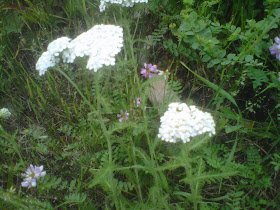This is a bit late, but my heart is in the right place. The garden is dragging me away from the computer these days. I have to garden when the temps and the rain are just right. It rained all day the other day so I could sit down and get caught up on blog posts!
When I taught the class out in Vernon Hills on cooking with herbs I discussed making herbal oils. My first rule with them is do not believe any book you see that says make them and store them for longer than a week. Unless you can pasteurize, it is just too dangerous to consume an herbal oil older than that. However, an herbal oil is a great gentle way to bring the flavor of herbs without the bulk of herbs into a dish or a dressing. And since it is salad season, I thought making Lemon Herb Oil would be a great How To.
Lemon Oil is also great to cook with and you can infuse the
oil overnight and use it for a couple of weeks (keeping it in the refrigerator) before needing a new batch. Chas and I enjoyed the batch I made for the lecture on chicken, salad, fish and even steak. We tried the Sage oil with the recipe I included at the end here, but I recommend just about any flavored oil will help you make amazing mashed potatoes.
Making Lemon Cooking Oil
Ingredients:
2 Tbls. freshly squeezed lemon juice
1 tsp lemon zest
1 tsp lime zest
1 handful of lemon herbs (lemon verbena, lemon basil, lemon
thyme, lemon balm or a combination is perfect)
+ I used lemon verbena, lemon thyme and lemon balm. The Lemon Basil was still too young when I did this in early May.
Steps:
1. Wash and air dry the herbs, then place them in a glass jar with a tight fitting plastic lid.
2. Squeeze the lemon juice. You notice that I cut the lemon peel (zest) off before I juiced it, much easier that way.
I grated the lime and peeled the lemon, it was more about after grating the lime I was too lazy to grate the lemon too!
3. Bruise the herbs in the jar lightly to release the essential oils.
4. Add the lemon juice and shake the jar to coat all the herbs with the juice.
5. Add one to 2 cups of good quality extra virgin olive oil. Remember you need a good quality base to make a good finished product when it comes to cooking oils.
6. Make sure all the herbs are under the oil and place the jar in the refrigerator overnight.
By the next day it is ready to cook with and can be used to make dressings, marinades and sauces.
Remember that the juice raises the water content, which can lead to spoiling, so keep it refrigerated when not being used and try to use it up in two weeks. If you do not use all of it in that time, please discard it and make a new batch. No need to get botulism!
Lemon Herb Oil
2 Tbls. freshly squeezed lemon juice
1 tsp lemon zest
1 tsp lime zest
1 handful of lemon herbs (lemon verbena, lemon basil, lemon
thyme, lemon balm or a combination is perfect)
Place herbs and zest in jar and bruise the herbs
lightly. Add lemon juice and shake to
spread it throughout the herbs. Add 1 to
2 cups of olive oil over the herbs until they are covered. Place in the refrigerator and meld
overnight. By the next day you are ready
to cook with it. Because of the juice
the water content is higher so do not keep this oil longer than 2 weeks and
always in the refrigerator.
Recipe to Try!
Olive Oil Mashed Potatoes
1 teaspoon anise seed, rosemary leaves, dried sage, or minced
garlic
2 lbs. new potatoes, peeled
½ cup flavored olive oil
salt & pepper
Directions:
Put seed, rosemary, sage or garlic in heavy skillet over
medium heat, toast for 4 minutes. Grind with a mortar and pestle. In a large
sauce pan, combine 2 quarts of water with a tablespoon of salt. Add potatoes and cook, covered 20 to 25
minutes until tender. Drain. Run
potatoes through a food mill or ricer. Stir
in oil, toasted herbs, salt and pepper. Serve with steaks or chicken filets. If you like a lumpier potato mash, just use a regular masher instead of ricer.



































